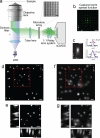Simultaneous whole-animal 3D imaging of neuronal activity using light-field microscopy
- PMID: 24836920
- PMCID: PMC4100252
- DOI: 10.1038/nmeth.2964
Simultaneous whole-animal 3D imaging of neuronal activity using light-field microscopy
Abstract
High-speed, large-scale three-dimensional (3D) imaging of neuronal activity poses a major challenge in neuroscience. Here we demonstrate simultaneous functional imaging of neuronal activity at single-neuron resolution in an entire Caenorhabditis elegans and in larval zebrafish brain. Our technique captures the dynamics of spiking neurons in volumes of ∼700 μm × 700 μm × 200 μm at 20 Hz. Its simplicity makes it an attractive tool for high-speed volumetric calcium imaging.
Figures



References
Publication types
MeSH terms
Substances
Grants and funding
LinkOut - more resources
Full Text Sources
Other Literature Sources
Molecular Biology Databases

